 Facebook
Facebook
 X
X
 Instagram
Instagram
 TikTok
TikTok
 Youtube
Youtube
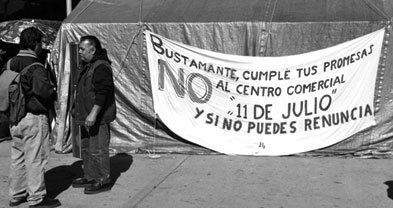
On the morning of April 12, a crowd of approximately 700 Tijuana residents, armed with placards and megaphones, shouted on the doorsteps of city hall, “¡Eco-cidio — no a la tala de arboles! ¡No al Zócalo once de julio!” The citizens group Movimiento Ciudadano en Defensa del Parque Benito Juárez (Citizens’ Movement for the Defense of Benito Juárez Park) held a rally against the proposed “Zócalo 11 de Julio,” a 900-million-peso ($76.9 million) plaza and commercial space designed for an area between the current municipal and state government buildings in the Zona Rio section of Tijuana.
The Project
“Tijuana is not Mexico.” — Raymond Chandler
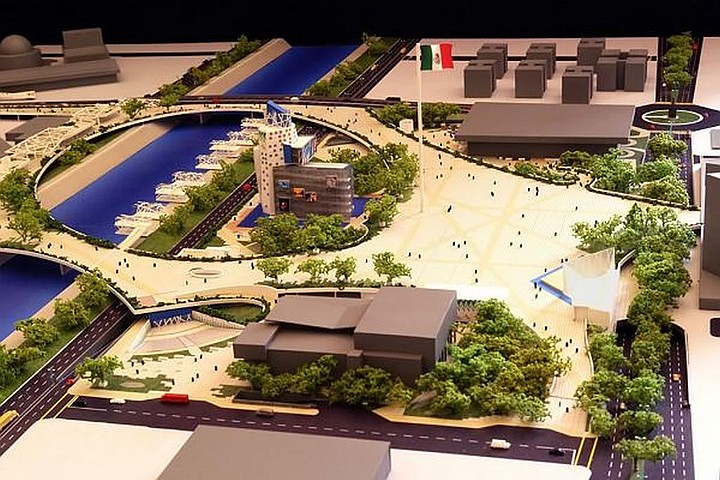
The ambitious Zócalo project was put together by a group of Tijuana business leaders and academics led by Carolina Aubanel, general manager of Sintesis Television, one of the major media networks in Baja California. In 2009, after forming a board, Zócalo proponents launched an architectural design competition for a 430,000-square-foot plaza (“zócalo”), to include space for 2000 cars, an open-air theater, library, galleries, and a retail zone, among other support spaces.
The plaza was baptized by the group as Zócalo 11 de Julio (July 11, 1889, is the official founding date of the city) and described to function in a similar manner as the one in Mexico City, located in an area built by the Spanish conquistadores on top of what was the major temple of Tenochtitlan. Like in many colonial cities in Latin America, the metropolitan cathedral and the national palace surround the zócalo. According to the competition brief, many cities in Mexico have zócalo-type plazas where the public can congregate to celebrate national festivities and promote cultural tourism. Also stated in the brief, this mega project will encourage the construction of a new identity for Tijuana and renovate the image of its urban realm.
The site selected for the design of the project is public land and is currently where the Benito Juárez Park lies, between the municipal and state building and across the street from the Tijuana cathedral that is now under construction. The existing park has an estimated 1300 trees of various species and is also the site of a major public library and the state-run cultural institute (ICBC), which went through a renovation and expansion three years ago. The area was created as part of a federally funded project in the 1970s with the intention to establish a new urban center for the city, which included the Tijuana River canal and Paseo de los Héroes, a major boulevard running eastward from the San Ysidro border crossing. The plan included the relocation of financial areas and government buildings from the original downtown area, near the infamous and historic Avenida Revolución.
The budget for the construction of the Zócalo project was first estimated at 900 million pesos, but experts today say its real cost is around 1.2 billion, almost a quarter of the City of Tijuana’s annual budget.
In March 2009, the competition winner was announced: a firm by the name of Black Dog, from the city of Monterrey in the border state of Nuevo Leon, located more than 2000 kilometers east of Tijuana. Yet, before the finalist was announced, the organizers selected five semifinalists and created a website for the public to vote for their favorite design (it was not clear if those votes had any bearing on determining the winner).
The winning design includes an oversized central oval plaza that connects with Tijuana’s new cathedral to the north and extends south across the Tijuana River to connect with the Plaza Rio shopping mall. The plaza makes a final link to the west with Tijuana’s cultural center (CECUT). Under the central plaza, there is a parking facility and a series of commercial spaces, yet the renderings of the project do not illustrate any remnants of the existing Benito Juárez Park. The concrete zócalo dominates much of the project site.
The Discordance
“The city and the urban sphere are thus the setting of struggle; they are also, however, the stakes of that struggle.” — Henri Lefebvre
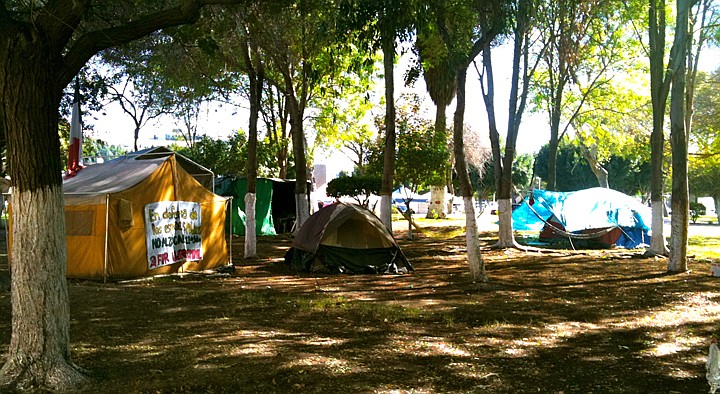
Activists for the preservation of Benito Juárez Park have been camping in the park for more than a year now. Their sentry posts are vigilant of any intent to cut down trees; they’re also on the lookout for heavy machinery threatening to begin construction of the project. Tents spread across the park hold up to eight people who form the permanent stronghold of the group; another 30 members come and go as needed to perform support tasks or participate in informing the thousands of citizens that visit city hall every day of their effort to save the park and its public spaces from private hands.
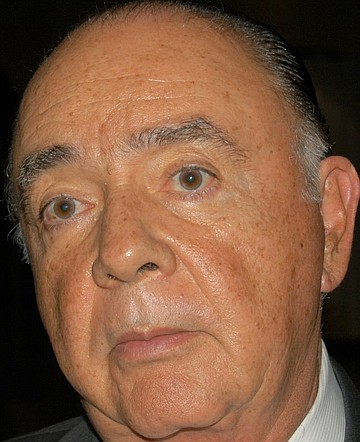
Preservationists’ two most urgent concerns are for the trees of the park and the turning over of what is now public land to private developers, which, according to the group, is being facilitated by the mayor’s office. Newly elected Tijuana mayor Carlos Bustamante is now in favor of the construction of the project; during his campaign for office he publicly stated that he was against it. Some people think that he hesitates to make up his mind because the president of the Zócalo board is his ex-wife, Carolina Aubanel.
According to the activists, the park and the rest of the block — including all existing buildings — are protected by a 1975 presidential decree stating that neither the state nor municipal governments can change the land-use ordinance established for the site. The legal council for the group has been victorious in getting an amparo (a constitutional protection) against the proposed project, but they are still wary of under-the-table dealings.
During the previous administration, a large area in front of city hall and adjacent to the park was converted into an underground parking garage that is operated by a private company. This area, until recently, was used as a public plaza where national festivities were celebrated throughout the year. Today, the parking structure has a series of low, unfinished columns that seem to be waiting to support floors above ground or a large plaza.
The preservationists have had moral and economic support from citizens and coverage from one major local media group known as PSN, which is covering their efforts on radio and cable television. Support from local councilmembers has been minimal and not amounted to any real gain against the project from within the local and state government.
As to their opinion about the architectural project, the group feels there is no real project. It is noticeable that the project is not entirely conceptualized, because every time the community criticizes its form or the lack of elements such as recreational areas and the need for park space, the architects keep redesigning the building to make it hold up to the demands. In the eyes of the citizens’ group, the design does not seem to be interpreted from a regional architecture. According to some, the central tower, designed as the new library, looks like a bad copy of the Burj Al Arabin hotel in Dubai.
As one activist expressed, “There is nothing real to the project; it only exists as a television commercial.”
Welcome to Megaflopolis
“The contemporary visitor looking for public urban places is increasingly forced to stroll through recycled and revalued areas…urban tableaux that have been turned into gentrified, historicized, commercialized, and privatized places.” — Christine Boyer
This project in all its essence is simulated, a spectacle, contrived in the mind of a television mogul and her entourage with the power of mass media forcing us to imagine their chimera as if it were our reality. This project is not a place, but only a virtual image; it is what New York architect and urban theorist Michael Sorkin calls “Cyburbia”: “An architecture of deception which, in its happy-face familiarity, constantly distances itself from the most fundamental realties. The architecture of this city is almost purely semiotic, playing the game of grafted signification, theme park building.”
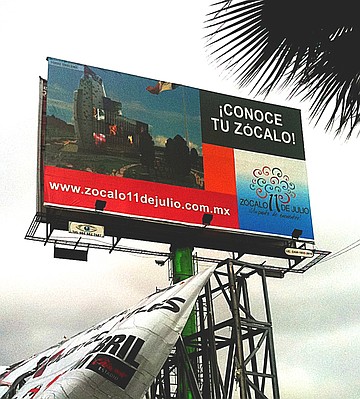
This romanticized idea of grafting a 300-year-old urban structure such as a zócalo within the contemporary city is to suffer from temporal amnesia and a retrograde effort to build the city in accordance to a time of colonial hegemony. They want to give us a transplanted identity and free-market urbanism, whether we like it or not.
Zócalo 11 de Julio as an idea seems to act out as a narcissistic desire to recontextualize an urban space that already has given form to diverse systems of coexistence, public and ecological. Yet, as the city to the east is being ghettoized (in consequence to giving private developers the power to build thousands of hectares of micro-houses), the board and its members want to build the Zócalo in an already active and central urban area, an action that reinforces the segregation of almost half of the population (it is documented that half of the population of Tijuana lives on the periphery), who don’t have access to public and recreational spaces. Investments like these need to be specific to the needs of the city, not just a neo-bourgeoisie fantasy. Tijuana needs to learn the term gentrification!
In terms of ecology, both sides are arguing about the number of trees — how many there are now and how many the Zócalo is proposing to plant. Instead of quantities, the important subject should concern “ecosystems” and areas that produce a favorable environment for the city. Tijuana is below the UN-suggested eight meters of green space per inhabitant: as of today, the city offers one meter of green space per inhabitant.
From Andrea Palladio to Le Corbusier, the relationships between power and land have been a critical theme in the formation of a democratic urban space. Different groups (social and political) have engaged in power struggles since the conception of contemporary urban space. Yet, the right to the city, as the geographer David Harvey defines it, “is not merely a right of access to what the property speculators and state planners define.” The design of public space must be a democratic and an inclusive endeavor and not left only to the private sector.
To read this article in Spanish, visit Tijuana en Español.


On the morning of April 12, a crowd of approximately 700 Tijuana residents, armed with placards and megaphones, shouted on the doorsteps of city hall, “¡Eco-cidio — no a la tala de arboles! ¡No al Zócalo once de julio!” The citizens group Movimiento Ciudadano en Defensa del Parque Benito Juárez (Citizens’ Movement for the Defense of Benito Juárez Park) held a rally against the proposed “Zócalo 11 de Julio,” a 900-million-peso ($76.9 million) plaza and commercial space designed for an area between the current municipal and state government buildings in the Zona Rio section of Tijuana.
The Project
“Tijuana is not Mexico.” — Raymond Chandler

The ambitious Zócalo project was put together by a group of Tijuana business leaders and academics led by Carolina Aubanel, general manager of Sintesis Television, one of the major media networks in Baja California. In 2009, after forming a board, Zócalo proponents launched an architectural design competition for a 430,000-square-foot plaza (“zócalo”), to include space for 2000 cars, an open-air theater, library, galleries, and a retail zone, among other support spaces.
The plaza was baptized by the group as Zócalo 11 de Julio (July 11, 1889, is the official founding date of the city) and described to function in a similar manner as the one in Mexico City, located in an area built by the Spanish conquistadores on top of what was the major temple of Tenochtitlan. Like in many colonial cities in Latin America, the metropolitan cathedral and the national palace surround the zócalo. According to the competition brief, many cities in Mexico have zócalo-type plazas where the public can congregate to celebrate national festivities and promote cultural tourism. Also stated in the brief, this mega project will encourage the construction of a new identity for Tijuana and renovate the image of its urban realm.
The site selected for the design of the project is public land and is currently where the Benito Juárez Park lies, between the municipal and state building and across the street from the Tijuana cathedral that is now under construction. The existing park has an estimated 1300 trees of various species and is also the site of a major public library and the state-run cultural institute (ICBC), which went through a renovation and expansion three years ago. The area was created as part of a federally funded project in the 1970s with the intention to establish a new urban center for the city, which included the Tijuana River canal and Paseo de los Héroes, a major boulevard running eastward from the San Ysidro border crossing. The plan included the relocation of financial areas and government buildings from the original downtown area, near the infamous and historic Avenida Revolución.
The budget for the construction of the Zócalo project was first estimated at 900 million pesos, but experts today say its real cost is around 1.2 billion, almost a quarter of the City of Tijuana’s annual budget.
In March 2009, the competition winner was announced: a firm by the name of Black Dog, from the city of Monterrey in the border state of Nuevo Leon, located more than 2000 kilometers east of Tijuana. Yet, before the finalist was announced, the organizers selected five semifinalists and created a website for the public to vote for their favorite design (it was not clear if those votes had any bearing on determining the winner).
The winning design includes an oversized central oval plaza that connects with Tijuana’s new cathedral to the north and extends south across the Tijuana River to connect with the Plaza Rio shopping mall. The plaza makes a final link to the west with Tijuana’s cultural center (CECUT). Under the central plaza, there is a parking facility and a series of commercial spaces, yet the renderings of the project do not illustrate any remnants of the existing Benito Juárez Park. The concrete zócalo dominates much of the project site.
The Discordance
“The city and the urban sphere are thus the setting of struggle; they are also, however, the stakes of that struggle.” — Henri Lefebvre

Activists for the preservation of Benito Juárez Park have been camping in the park for more than a year now. Their sentry posts are vigilant of any intent to cut down trees; they’re also on the lookout for heavy machinery threatening to begin construction of the project. Tents spread across the park hold up to eight people who form the permanent stronghold of the group; another 30 members come and go as needed to perform support tasks or participate in informing the thousands of citizens that visit city hall every day of their effort to save the park and its public spaces from private hands.

Preservationists’ two most urgent concerns are for the trees of the park and the turning over of what is now public land to private developers, which, according to the group, is being facilitated by the mayor’s office. Newly elected Tijuana mayor Carlos Bustamante is now in favor of the construction of the project; during his campaign for office he publicly stated that he was against it. Some people think that he hesitates to make up his mind because the president of the Zócalo board is his ex-wife, Carolina Aubanel.
According to the activists, the park and the rest of the block — including all existing buildings — are protected by a 1975 presidential decree stating that neither the state nor municipal governments can change the land-use ordinance established for the site. The legal council for the group has been victorious in getting an amparo (a constitutional protection) against the proposed project, but they are still wary of under-the-table dealings.
During the previous administration, a large area in front of city hall and adjacent to the park was converted into an underground parking garage that is operated by a private company. This area, until recently, was used as a public plaza where national festivities were celebrated throughout the year. Today, the parking structure has a series of low, unfinished columns that seem to be waiting to support floors above ground or a large plaza.
The preservationists have had moral and economic support from citizens and coverage from one major local media group known as PSN, which is covering their efforts on radio and cable television. Support from local councilmembers has been minimal and not amounted to any real gain against the project from within the local and state government.
As to their opinion about the architectural project, the group feels there is no real project. It is noticeable that the project is not entirely conceptualized, because every time the community criticizes its form or the lack of elements such as recreational areas and the need for park space, the architects keep redesigning the building to make it hold up to the demands. In the eyes of the citizens’ group, the design does not seem to be interpreted from a regional architecture. According to some, the central tower, designed as the new library, looks like a bad copy of the Burj Al Arabin hotel in Dubai.
As one activist expressed, “There is nothing real to the project; it only exists as a television commercial.”
Welcome to Megaflopolis
“The contemporary visitor looking for public urban places is increasingly forced to stroll through recycled and revalued areas…urban tableaux that have been turned into gentrified, historicized, commercialized, and privatized places.” — Christine Boyer
This project in all its essence is simulated, a spectacle, contrived in the mind of a television mogul and her entourage with the power of mass media forcing us to imagine their chimera as if it were our reality. This project is not a place, but only a virtual image; it is what New York architect and urban theorist Michael Sorkin calls “Cyburbia”: “An architecture of deception which, in its happy-face familiarity, constantly distances itself from the most fundamental realties. The architecture of this city is almost purely semiotic, playing the game of grafted signification, theme park building.”

This romanticized idea of grafting a 300-year-old urban structure such as a zócalo within the contemporary city is to suffer from temporal amnesia and a retrograde effort to build the city in accordance to a time of colonial hegemony. They want to give us a transplanted identity and free-market urbanism, whether we like it or not.
Zócalo 11 de Julio as an idea seems to act out as a narcissistic desire to recontextualize an urban space that already has given form to diverse systems of coexistence, public and ecological. Yet, as the city to the east is being ghettoized (in consequence to giving private developers the power to build thousands of hectares of micro-houses), the board and its members want to build the Zócalo in an already active and central urban area, an action that reinforces the segregation of almost half of the population (it is documented that half of the population of Tijuana lives on the periphery), who don’t have access to public and recreational spaces. Investments like these need to be specific to the needs of the city, not just a neo-bourgeoisie fantasy. Tijuana needs to learn the term gentrification!
In terms of ecology, both sides are arguing about the number of trees — how many there are now and how many the Zócalo is proposing to plant. Instead of quantities, the important subject should concern “ecosystems” and areas that produce a favorable environment for the city. Tijuana is below the UN-suggested eight meters of green space per inhabitant: as of today, the city offers one meter of green space per inhabitant.
From Andrea Palladio to Le Corbusier, the relationships between power and land have been a critical theme in the formation of a democratic urban space. Different groups (social and political) have engaged in power struggles since the conception of contemporary urban space. Yet, the right to the city, as the geographer David Harvey defines it, “is not merely a right of access to what the property speculators and state planners define.” The design of public space must be a democratic and an inclusive endeavor and not left only to the private sector.
To read this article in Spanish, visit Tijuana en Español.